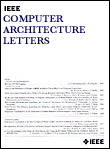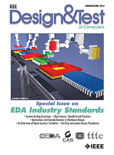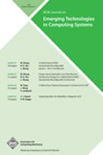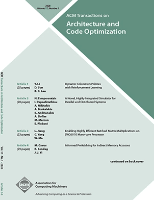
IEEE Computer Architecture Letters
Scope & Guideline
Elevating Research Standards in Hardware and Architecture.
Introduction
Aims and Scopes
- Architectural Innovation and Design:
The journal publishes research on novel architectural designs for processors, memories, and systems that enhance performance and efficiency. - Performance Evaluation and Modeling:
It includes studies involving simulation and modeling of computer architectures to assess their performance under various workloads. - Energy Efficiency and Sustainability:
Research that addresses energy consumption and sustainability in computing systems is a core focus, aiming to develop architectures that are more power-efficient. - Security in Computer Architecture:
The journal highlights the importance of security in computer architecture, exploring methods to mitigate vulnerabilities and enhance system integrity. - Emerging Technologies and Applications:
It also covers advancements in emerging technologies such as quantum computing, machine learning accelerators, and non-volatile memory systems. - Memory Systems and Management:
Research on memory architecture, including novel memory hierarchies and data management techniques, is an essential area of the journal.
Trending and Emerging
- Processing-in-Memory (PIM) Architectures:
There is a rising trend in research on PIM architectures, which aim to reduce data movement and improve efficiency by integrating processing capabilities directly within memory. - Machine Learning and AI Acceleration:
The journal is increasingly focusing on hardware architectures designed specifically for accelerating machine learning and AI workloads, reflecting the growing importance of these technologies. - Quantum Computing Architectures:
Research on quantum computing architectures is gaining traction, as scientists explore new designs to optimize quantum algorithms and improve error correction. - Security Architecture Innovations:
Innovations in security architectures are becoming more prominent, with a focus on developing hardware solutions to counteract emerging threats and vulnerabilities. - Energy-Efficient Computing Solutions:
There is a significant emphasis on energy-efficient computing solutions, particularly in the context of sustainable computing and the reduction of carbon footprints in data centers. - Graph Processing and Neural Network Acceleration:
The rise of graph processing and specialized architectures for neural networks has become a key area of interest, driven by the increasing complexity of AI models and applications.
Declining or Waning
- Traditional CPU Architecture:
Research focused on conventional CPU architectures is becoming less prevalent, as the field shifts towards more specialized architectures and accelerators. - Legacy Systems and Compatibility:
Studies on legacy systems and their compatibility with modern technologies are appearing less frequently, indicating a move away from older paradigms. - Single-Core Performance Optimization:
The focus on optimizing single-core performance has waned, with more researchers exploring multi-core and heterogeneous computing solutions. - General-Purpose GPU Utilization:
There is a noticeable decrease in publications centered around general-purpose GPU architectures, as the field moves towards more tailored solutions for specific applications. - Static Hardware Design Approaches:
Static design methodologies are being overshadowed by dynamic and adaptive architecture designs that respond to workload variations.
Similar Journals

Frontiers of Architectural Research
Illuminating the Path of Architectural AdvancementFrontiers of Architectural Research, published by KEAI PUBLISHING LTD, stands at the forefront of interdisciplinary scholarship, addressing contemporary challenges in the fields of architecture, urban studies, building and construction, and archaeology. Since its establishment in 2012, this open-access journal has rapidly gained recognition, achieving prestigious rankings in the 2023 category quartiles, including Q1 placements in both Architecture and Archaeology. With an impressive Scopus rank of #5 out of 354 in Archaeology and #10 out of 189 in Engineering - Architecture, it demonstrates its significant influence and contribution to advancing architectural research. Frontiers of Architectural Research embraces a broad scope that fosters innovative discourse and practical solutions, catering to a diverse audience of researchers, professionals, and students keen on exploring the intersection of culture, environment, and technology. By ensuring immediate access to research findings, the journal not only enhances the visibility of scholarly work but also encourages collaborative dialogues that shape the future of architectural practice.

IEEE Design & Test
Fostering Collaboration for Technological AdvancementsIEEE Design & Test is a leading academic journal published by the IEEE-INST ELECTRICAL ELECTRONICS ENGINEERS INC, dedicated to advancing the fields of Electrical and Electronic Engineering, Hardware and Architecture, and Software. With an ISSN of 2168-2356 and an E-ISSN of 2168-2364, the journal spans from 2013 to 2024, offering valuable insights and peer-reviewed research that addresses critical challenges in the design, verification, and testing of electronic systems. Recognized for its quality, the journal holds a Q2 designation in Electrical and Electronic Engineering and ranks within the top quartiles of its category, making it a notable resource for professionals and scholars alike. Its Scopus rankings, particularly a rank of #354 in Electrical and Electronic Engineering, underscores its significance and relevance in the rapidly evolving technological landscape. Although not currently open access, the journal remains committed to disseminating innovative research that shapes the future of technology, ensuring that researchers and practitioners stay at the forefront of their disciplines. IEEE Design & Test serves as an essential platform for exchanging ideas, fostering collaboration, and driving advancements in engineering and computer science.

NEW GENERATION COMPUTING
Elevating Academic Insights in Theoretical Computer ScienceNEW GENERATION COMPUTING is a prominent academic journal published by SPRINGER, specializing in the dynamic fields of Computer Networks, Hardware and Architecture, Software Engineering, and Theoretical Computer Science. With a commitment to disseminating high-quality research since its inception in 1983 and extending its coverage to 2024, this journal occupies a vital role in advancing knowledge and innovation within these critical domains. Holding prestigious Q2 rankings in Computer Networks and Communications, Hardware and Architecture, and Software, as well as a Q3 ranking in Theoretical Computer Science for 2023, NEW GENERATION COMPUTING attracts significant contributions from scholars and professionals around the globe. Researchers will find its rigorous peer-review process ensures the publication of impactful studies, while students gain access to cutting-edge research that shapes contemporary computing practices. Though it does not offer open access, the journal remains an invaluable resource in the academic community, fostering collaboration and dialogue among experts aiming to push the boundaries of technology.

Prostor
Advancing Architectural Dialogue for a Sustainable FutureProstor is an esteemed scholarly journal published by the University of Zagreb, Faculty of Architecture, dedicated to advancing knowledge in the fields of architecture, urban planning, and spatial studies. Since transitioning to an Open Access model in 2006, Prostor has made significant strides in providing unrestricted access to its contents, fostering a vibrant community of researchers, practitioners, and students interested in contemporary issues surrounding the built environment and social space. The journal's commitment to quality is reflected in its impressive rank within Scopus, particularly in the Arts and Humanities category (64th percentile) and within Engineering (Architecture) at the 49th percentile. Covering a broad array of interdisciplinary topics, Prostor serves as a vital platform for disseminating innovative research and fostering dialogue among professionals while engaging with practical and theoretical explorations of spatial design. With coverage spanning over two decades, Prostor remains a crucial resource for anyone seeking to navigate the complexities of architecture and urban studies.

ACM Journal on Emerging Technologies in Computing Systems
Shaping Tomorrow's Technology Landscape TodayACM Journal on Emerging Technologies in Computing Systems, published by the Association for Computing Machinery, stands as a premier platform dedicated to the exploration and discussion of avant-garde advancements in computing systems. With an ISSN of 1550-4832 and an E-ISSN of 1550-4840, this journal has achieved notable recognition, holding a 2023 Q2 ranking in key fields such as Electrical and Electronic Engineering, Hardware and Architecture, Nanoscience and Nanotechnology, and Software. Spanning from 2005 to 2024, it provides a critical forum for researchers, professionals, and students alike to disseminate innovative research and applications that shape the future of technology. Although currently not open access, the journal's commitment to high-quality, peer-reviewed content ensures its relevance and impact, as reflected in its competitive Scopus ranks across various disciplines. Engage with groundbreaking research that propels the frontiers of computational systems in this dynamic academic journal.

International Journal of Embedded Systems
Transforming Ideas into Embedded SolutionsInternational Journal of Embedded Systems, published by INDERSCIENCE ENTERPRISES LTD, is a pivotal platform for researchers and professionals engaged in the dynamic fields of embedded systems, hardware, and software architecture. Established in 2005, this journal addresses the intricate interplay between software and hardware components in embedded system design and offers valuable insights into the latest advancements and methodologies. With its ISSN 1741-1068 and E-ISSN 1741-1076, it showcases rigorous peer-reviewed articles that contribute significantly to ongoing discourse and innovation in the field. Despite its current ranking in the Q4 category for both Hardware and Architecture and Software, the journal serves as a crucial resource for the development and enhancement of embedded technology. Researchers are encouraged to explore this journal to stay abreast of emerging trends and foster collaborations that advance knowledge in this complex domain. Note that the journal does not currently offer open access options, which may affect dissemination and accessibility for the wider academic community.

ACM Transactions on Architecture and Code Optimization
Shaping the Evolution of Architecture and CodeACM Transactions on Architecture and Code Optimization, published by the Association for Computing Machinery (ACM), serves as a premier journal in the fields of architecture, hardware, and software optimization. With an ISSN of 1544-3566 and E-ISSN of 1544-3973, this journal provides a platform for innovative research and discussion from 2004 to 2024, reflecting its commitment to the evolving landscape of computer science. Holding a Q2 ranking in key categories such as Hardware and Architecture, Information Systems, and Software, it stands out in its field, catering to a broad audience of researchers, professionals, and students alike. While the journal does not currently offer open access, subscribers can benefit from an array of valuable insights into cutting-edge techniques for optimizing code and architectural designs. Its rigorous peer-review process ensures that only high-quality, impactful research is published, making it an essential resource for those seeking to advance their knowledge and practice in these vital areas of computing.

Festival dell Architettura Magazine
Illuminating Contemporary Architectural ThoughtFestival dell Architettura Magazine, published by FESTIVAL ARCHITETTURA EDIZIONI, is a distinctive Open Access journal dedicated to the realms of architecture, urban studies, and the visual and performing arts. Established with a vision to foster interdisciplinary dialogue, the journal has been a part of the academic landscape since 2013 and has converged its insightful contributions from 2018 to 2023. Despite being ranked in the lower quartiles in its respective categories—Q4 in Architecture and Urban Studies, and Q3 in Visual Arts and Performing Arts—this publication remains vital for emerging researchers and seasoned professionals alike, as it provides a platform for innovative ideas and practices from Italy and beyond. It serves as a key resource for those who wish to engage with contemporary architectural thought and cultural expressions, facilitating open access to research that highlights the intersections of space, society, and art.

WORLD WIDE WEB-INTERNET AND WEB INFORMATION SYSTEMS
Elevating Standards in Web-Based Information StudiesWORLD WIDE WEB - INTERNET AND WEB INFORMATION SYSTEMS, published by Springer, is a leading academic journal that focuses on the cutting-edge areas of Internet technologies and web-based information systems. With an esteemed ISSN of 1386-145X and an E-ISSN of 1573-1413, this journal has been a significant contributor to the fields of Computer Networks and Communications, Hardware and Architecture, and Software since its inception in 1998. The journal consistently ranks in the Q1 category across these fields, reflecting its high impact and relevance, evidenced by its impressive Scopus rankings where it stands in the upper percentiles (79th for Computer Networks and Communications, 77th for Hardware and Architecture, and 75th for Software). Researchers, professionals, and students looking to stay at the forefront of web information systems will find a wealth of valuable resources and innovative research compellingly presented in this journal, available for publication until 2024.

Journal of Architecture and Planning -King Saud University
Elevating Research in Architecture and Planning.Journal of Architecture and Planning, published by King Saud University Press, serves as a critical platform for scholarly dialogue and innovation within the field of architecture and urban planning. This peer-reviewed journal, bearing the ISSN 1018-3604, aims to disseminate high-quality research that addresses contemporary challenges in architectural design, environmental sustainability, and urban development. Situated in Riyadh, Saudi Arabia, this journal not only highlights regional architectural practices but also fosters global discussions, making it an essential resource for researchers, professionals, and students alike. Although currently not open access, the journal is dedicated to providing extensive coverage of the latest findings and theoretical advancements in architecture and planning, paving the way for impactful contributions that can transform communities and enhance the built environment.